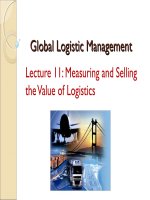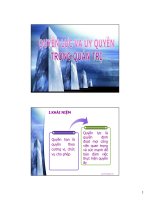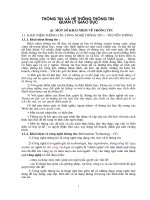BÀI GIẢNG 11 ĐO VÀ BÁN GIÁ TRỊ QUẢN LÝ pot
Bạn đang xem bản rút gọn của tài liệu. Xem và tải ngay bản đầy đủ của tài liệu tại đây (423.29 KB, 14 trang )
Global Logistic Management
Global Logistic Management
Lecture 11: Measuring and Selling
the Value of Logistics
Agenda
Agenda
1 Options For Measuring Value
2 Components of Customer Value
3 How Customers Select Among
Competitive Suppliers
4 Definition of Customer Value-Added
5 Calculating CVA
6 How Logistic Affects CVA
7 Selling The Value Advantages
Options for Measuring Value
Options for Measuring Value
1. Customer satisfaction
2. Customer value-added (CVA)
3. Total cost analysis
4. Profitability analysis (includes
considerations)
5. Strategic profit model
6. Shareholder value
Components of Customer Value
Product
attributes
Service
attributes
Transaction
cost
Expected
customer
value
Perceived benefit
Perceived sacrifice
Risk
Life cycle
cost
Source: Earl Naumann,
Creating Customer Value: The Path to Sustainable Competitive Advantage
(Cincinnati, OH: Thomson Executive Press, 1995), p. 103.
How Customers Select Among
How Customers Select Among
Competitive Suppliers
Competitive Suppliers
•
Customer buys on value
•
Value equals quality relative to price
•
Quality includes all non-price attributes
Product Customer Service
•
Quality, price, and value are relative
Value
Quality
Price
Customer
service
Product
Source:Bradley T. Gale,
Managing Customer Value
(New York: The Free Press, 1994), p. 29.
Creating Value That Customers
Creating Value That Customers
Can See
Can See
Understanding
customer needs in a
well-defined market
Superior quality in
areas that matter to
customers
Market-perceived
quality
Exceptional customer
value
Business results
Profitability, growth,
and shareholder value
Advertising and
other marketing
communications
Low “cost of
quality” and overall
cost leadership
Effective design and
quality control
Source:Bradley T. Gale,
Managing Customer Value
(New York: The Free Press, 1994), p. 19.
Customer Value Added
Customer Value Added
Provide products and services to customers
that are a better value than those they could
purchase from competitive companies in
similar markets
Customer Satisfaction Market Share
THE VALUE QUESTION
–
Considering the products and
services that you purchased. How
would you rate them as being worth
what you paid for them?
Calculating CVA
CVA =
Perceived Value of Company’s Offer
Perceived Value of Competitive Offers
Order Fulfillment Customer
Order Fulfillment Customer
Satisfaction Survey Results Delivering Material
Satisfaction Survey Results Delivering Material
Performance
(1 poor…5 excellent)
Ratio
Questions Attributes Company
Best Other
Vendor
Company/best
Other Vendor
Delivering Material When You Wanted It 3.35 3.32 1.01
Having the Necessary Info on All Shipping
Documentation
3.67 NA
Having the Correct Materials Delivered Relative
to What You Ordered
4.00 3.76 1.05
Overall Quality of Delivery of Materials 3.89 3.74 1.04
Total Cost Analysis
Total Cost Analysis
Purchase Price
plus
Transportation costs
Inventory turns
Terms of sale
Ordering costs
Receiving costs
_______________
_______________
_______________
Copyright © 2001 by The McGraw-Hill Companies, Inc. All rights reserved.
Segment Profitability Analysis:
A CONTRIBUTION APPROACH WITH
CHARGE FOR ASSETS EMPLOYED
SUPPLIER A SUPPLIER B SUPPLIER C SUPPLIER D
SALES
COST OF GOODS SOLD
VARIABLE MARKETING & LOGISTICS COSTS:
ASSIGNABLE NONVARIBLE COSTS:
SALARIES
ADVERTISING
INVENTORY CARRYING COSTS LESS:
GROSS MARGIN
TRANSPORTATION
RECEIVING
ORDER PROCESSING
PLUS: DISCOUNTS AND ALLOWANCES
MARKET DEVELOPMENT FUNDS
SLOTTING ALLOWANCES
CO-OP ADVERTISING
NET MARGIN
_____________
_____________
CHARGE FOR ACCOUNTS PAYABLE
CONTRIBUTION MARGIN
SEGMENT CONTROLLABLE MARGIN
_____________
_____________
IMPACT OF LOGISTICS ON RETURN ON NET WORTH
net sales
total assets
STRATEGIC PROFIT MODEL
X
$
$
$
$
$
$
%
Net Profit
Margin
net profit
net sales
÷
Net Profit
Sales
_
Gross Margin
Total Expenses
Sales
_
Cost of
Goods Sold
Variable
Expenses
- Sales increase due to better
customer service
- Fewer LTL shipments
- Fewer freight claims
- Lower freight costs
- Insurance
- Taxes
- Variable Storage costs
- Inventory risk costs
$
$
$
$
$
$
$
÷
Sales
Total Assets
+
Fixed Assets
Current Assets
Inventory
+
Accounts
Receivable
+
Other
Current Assets
%
Return on
Net Worth
Net profit
net worth
Total assets
net worth
Net profit
total assets
=
=
Financial
Leverage
Return on
Assets
X
X
- Fewer employees required
- Lower third-party warehousing costs
Reduced IS costs
Reduced cost of supervision
Reduced inventory investment
Reduced due to more prompt
paying customers (reduced errors)
General and
Administrative
Information
Systems
Warehousing
Costs
Inventory
Carrying
Costs
Transportation
Costs
- Lower cost due to new or more
efficient manufacturing facilities
Logistics’ Impact
Lot Quantity
Costs
- Reduced order management costs
- Fewer last minute production changes
Less warehouse space required
Increase investment in modernized
production facilities
- Lower cost of purchased materials
Asset
Turnover
How Logistics Affects EVA
Working
Capital
Fixed
Assets
Transportation Costs
Warehousing Costs
Lot Quantity Costs
Information System Costs
Non Cost of Money Components
of Inventory Carrying Cost
Equipment/Vehicles
Accounts Receivable
Land/Facilities (owned)
Inventory
Equipment/Facilities (leased)
Net Operating
Profit After Taxes
(NOPAT)
EVA
Revenue
Customer Service Levels
Capital
Charge
Expenses
Cost of
Capital
=
x
+
Source: Douglas M. Lambert and Renan Burduroglu, "Measuring and Selling the Value of Logistics,"
The International Journal of Logistics Management
, Vol.11, No.1 (2000), p.12.
Selling the Value Advantage
Selling the Value Advantage
Who is the customer?
Must measure value from the
customer’s perspective
Market segmentation based on value
Value is a moving target
Changing role of the sales force
Copyright © 2001 by The McGraw-Hill Companies, Inc. All rights reserved.









